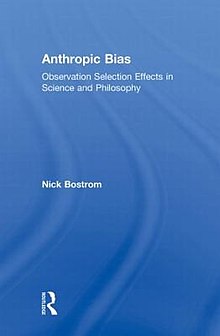The anthropic principle, also known as the "observation selection effect", is the hypothesis, first proposed in 1957 by Robert Dicke, that the range of possible observations that could be made about the universe is limited by the fact that observations could happen only in a universe capable of developing intelligent life. Proponents of the anthropic principle argue that it explains why the universe has the age and the fundamental physical constants necessary to accommodate conscious life, since if either had been different, no one would have been around to make observations. Anthropic reasoning is often used to deal with the idea that the universe seems to be finely tuned for the existence of life.
In philosophy, the philosophy of physics deals with conceptual and interpretational issues in modern physics, many of which overlap with research done by certain kinds of theoretical physicists. Historically, philosophers of physics have engaged with questions such as the nature of space, time, matter and the laws that govern their interactions, as well as the epistemological and ontological basis of the theories used by practicing physicists. The discipline draws upon insights from various areas of philosophy, including metaphysics, epistemology, and philosophy of science, while also engaging with the latest developments in theoretical and experimental physics.
Statistical bias, in the mathematical field of statistics, is a systematic tendency in which the methods used to gather data and generate statistics present an inaccurate, skewed or biased depiction of reality. Statistical bias exists in numerous stages of the data collection and analysis process, including: the source of the data, the methods used to collect the data, the estimator chosen, and the methods used to analyze the data. Data analysts can take various measures at each stage of the process to reduce the impact of statistical bias in their work. Understanding the source of statistical bias can help to assess whether the observed results are close to actuality. Issues of statistical bias has been argued to be closely linked to issues of statistical validity.
The mediocrity principle is the philosophical notion that "if an item is drawn at random from one of several sets or categories, it's more likely to come from the most numerous category than from any one of the less numerous categories". The principle has been taken to suggest that there is nothing very unusual about the evolution of the Solar System, Earth's history, the evolution of biological complexity, human evolution, or any one nation. It is a heuristic in the vein of the Copernican principle, and is sometimes used as a philosophical statement about the place of humanity. The idea is to assume mediocrity, rather than starting with the assumption that a phenomenon is special, privileged, exceptional, or even superior.
Inductive reasoning is any of various methods of reasoning in which broad generalizations or principles are derived from a body of observations. This article is concerned with the inductive reasoning other than deductive reasoning, where the conclusion of a deductive argument is certain given the premises are correct; in contrast, the truth of the conclusion of an inductive argument is at best probable, based upon the evidence given.
Selection bias is the bias introduced by the selection of individuals, groups, or data for analysis in such a way that proper randomization is not achieved, thereby failing to ensure that the sample obtained is representative of the population intended to be analyzed. It is sometimes referred to as the selection effect. The phrase "selection bias" most often refers to the distortion of a statistical analysis, resulting from the method of collecting samples. If the selection bias is not taken into account, then some conclusions of the study may be false.

Nick Bostrom is a philosopher known for his work on existential risk, the anthropic principle, human enhancement ethics, whole brain emulation, superintelligence risks, and the reversal test. He was the founding director of the now dissolved Future of Humanity Institute at the University of Oxford and is now Principal Researcher at the Macrostrategy Research Initiative.
Frank Jennings Tipler is an American mathematical physicist and cosmologist, holding a joint appointment in the Departments of Mathematics and Physics at Tulane University. Tipler has written books and papers on the Omega Point based on Pierre Teilhard de Chardin's religious ideas, which he claims is a mechanism for the resurrection of the dead. He is also known for his theories on the Tipler cylinder time machine. His work has attracted criticism, most notably from Quaker and systems theorist George Ellis who has argued that his theories are largely pseudoscience.
The characterization of the universe as finely tuned intends to explain why the known constants of nature, such as the electron charge, the gravitational constant, and the like, have their measured values rather than some other arbitrary values. According to the "fine-tuned universe" hypothesis, if these constants' values were too different from what they are, "life as we know it" could not exist. In practice, this hypothesis is formulated in terms of dimensionless physical constants.

The doomsday argument (DA), or Carter catastrophe, is a probabilistic argument that claims to predict the future population of the human species based on an estimation of the number of humans born to date. The doomsday argument was originally proposed by the astrophysicist Brandon Carter in 1983, leading to the initial name of the Carter catastrophe. The argument was subsequently championed by the philosopher John A. Leslie and has since been independently conceived by J. Richard Gott and Holger Bech Nielsen. Similar principles of eschatology were proposed earlier by Heinz von Foerster, among others. A more general form was given earlier in the Lindy effect, which proposes that for certain phenomena, the future life expectancy is proportional to the current age and is based on a decreasing mortality rate over time.
The Great Filter is the idea that, in the development of life from the earliest stages of abiogenesis to reaching the highest levels of development on the Kardashev scale, there is a barrier to development that makes detectable extraterrestrial life exceedingly rare. The Great Filter is one possible resolution of the Fermi paradox.

Human extinction is the hypothetical end of the human species, either by population decline due to extraneous natural causes, such as an asteroid impact or large-scale volcanism, or via anthropogenic destruction (self-extinction), for example by sub-replacement fertility.
The self-indication assumption doomsday argument rebuttal is an objection to the doomsday argument by arguing that the chance of being born is not one, but is an increasing function of the number of people who will be born.
The self-referencing doomsday argument rebuttal is an attempt to refute the doomsday argument by applying the same reasoning to the lifetime of the doomsday argument itself.
In string theory, the string theory landscape is the collection of possible false vacua, together comprising a collective "landscape" of choices of parameters governing compactifications.

The Sleeping Beauty problem, also known as the Sleeping Beauty paradox, is a puzzle in decision theory in which an ideally rational epistemic agent is told she will be awoken from sleep either once or twice according to the toss of a coin. Each time she will have no memory of whether she has been awoken before, and is asked what her degree of belief that the outcome of the coin toss is Heads ought to be when she is first awakened.

The Future of Humanity Institute (FHI) was an interdisciplinary research centre at the University of Oxford investigating big-picture questions about humanity and its prospects. It was founded in 2005 as part of the Faculty of Philosophy and the Oxford Martin School. Its director was philosopher Nick Bostrom, and its research staff included futurist Anders Sandberg and Giving What We Can founder Toby Ord.

The Boltzmann brain thought experiment suggests that it might be more likely for a single brain to spontaneously form in space, complete with a memory of having existed in our universe, rather than for the entire universe to come about in the manner cosmologists think it actually did. Physicists use the Boltzmann brain thought experiment as a reductio ad absurdum argument for evaluating competing scientific theories.

The simulation hypothesis proposes that what humans experience as the world is actually a simulated reality, such as a computer simulation in which humans themselves are constructs. There has been much debate over this topic, ranging from philosophical discourse to practical applications in computing.







